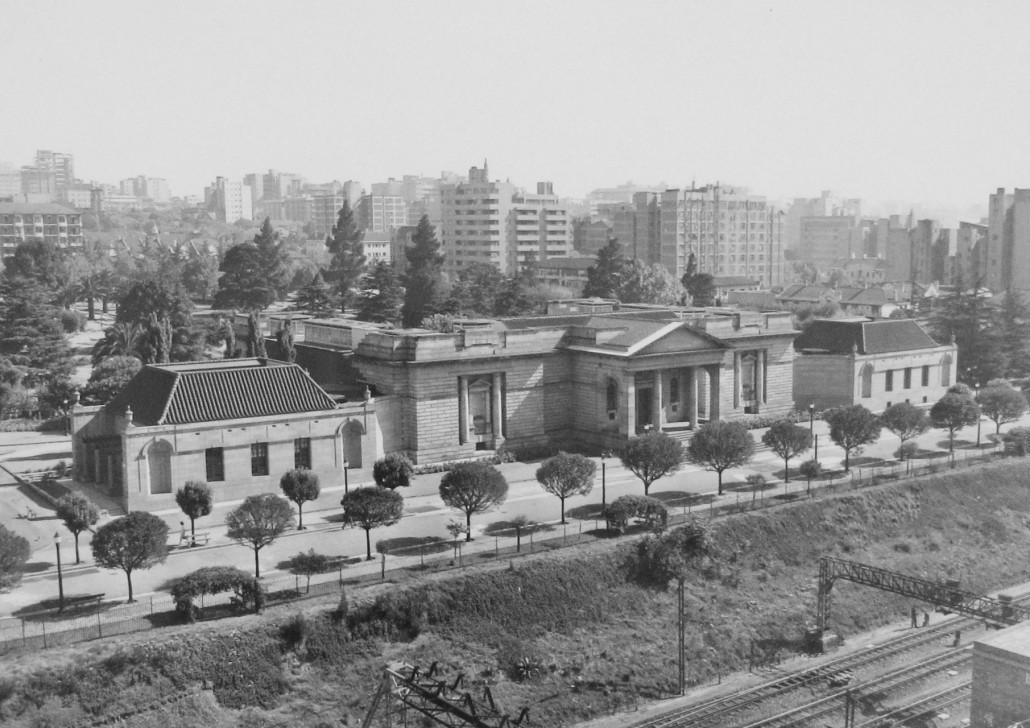Johannesburg Art Gallery
(Edwin Lutyens, 1910-1914; 1936-1940)
Lutyens was invited to visit South Africa in November/December 1910, to discuss the Art Gallery project through the good offices of Baker, and at the expense of Florrie Phillips (wife of the Randlord, Sir Lionel Phillips) who was the begetter of the project, with the Irish art dealer and connoisseur, Sir Hugh Lane, as adviser. The city council had agreed a site in Joubert Park, a green oasis in the fast-developing city. As ever, Lutyens’s enthusiasm and aspiration was boundless. He raised his sights towards re-planning Joubert Park itself, bridging the railway to connect to a broad civic square to the south, and even attempted to move the agreed site for the cathedral into his scheme. He was safely back in England, when Florrie was beset by difficulties raising money for the first phase, and local architects protested at the appointment of an outsider. Construction was impeded by the lack of funds, and delays in sending the working drawings from England. The first phase was opened in 1915, with two of the intended four wings added in the late 1930s, to a simplified, stripped classical design by EL.
In 1987 the gallery was substantially extended by Meyer Pienaar, completing the symmetry of the Lutyens plan without attempting to reproduce his details. The overall result is not without interest. Sandstone fades into a light brick, and simplified arch details consisting of a skeleton semi-circular arch and keystone within a rectangular opening, quite a Lutyensian detail in itself, helped the transition from old to new. The main entrance was reversed around to the north side, with a ramped approach above a formal pool and cascade visible internally from the underground galleries. The least effective feature is the exposing of the copper vaulted roofs of the underground galleries, which look like a series of covered wagons parked in front of the building. They might also suggest a defensive laager, as the building now appears to be under siege, behind a high security fence in a highly dangerous location. Moreover, the finishes and structure of the extension have deteriorated.
Approaching the building towards the now disused portico, cramped against the railway cutting, the detailing of the building is of great interest. Lutyens was influenced by Inigo Jones’s church portico in the Covent Garden piazza, while the largely blank front elevation shows affinity with George Dance’s Old Newgate gaol, one of Els favourites, demolished in 1902. There is a clear distinction between the Wren-influenced Lutyens of 1910, and his later elemental style in the two wings which were added in the late 1930s, and opened in 1940. These latter were of great interest in that they had affinity of detail with Liverpool Roman Catholic Cathedral, and the pergolas were comparable with those found on Halnaker in Sussex, built in 1935-7.
Internally, the juxtaposition of old and new seems to work quite well. The main barrel-vaulted gallery opening from a shallow foyer behind the portico was the first part to be completed. It has refined plaster detail on the ceiling, and three large arched windows facing the central courtyard. In order to conserve the paintings the shutters are now kept closed below the semi-circular upper lights. The shutter hinges on the main gallery windows, facing into the central courtyard, bore the hallmarks of George Ness, Baker’s favourite metalworker. The detailing was superb, (some of it reputedly by Baker’s protégé, Joseph Michael Solomon, who worked in EL’s office in 1911. Bold Classical mouldings and cornices, are now made even more striking against the brightly painted walls. While some of these looked rather strident, it must be remembered that Lutyens himself used bold colour combinations, not least in his own home, where the drawing room had black walls above a white dado, with white cornice and ceiling mouldings, and an emerald green stained wood floor. The later Lutyens galleries were set lower, and the transitional spaces and steps were as always inventively detailed, with compressed spaces and vaults worthy of Soane. It was interesting to note the relatively sophisticated arrangements Lutyens had made for diffused top lighting. Moreover, even from the start the building had a primitive system of air circulation.
The Johannesburg Art Gallery was an early portent of EL’s entry into the High Game of classicism, and a landmark en route to New Delhi. It is to be hoped that the problems, which beset its location, can be overcome.
Mervyn Miller



